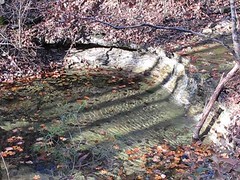 Image by gmeador via FlickrThe Ozark chinquapin is a medium-sized tree which once grew to 65 feet, but now rarely reaches heights of more than 30 feet. It develops from stump sprouts as well as seeds, but in recent years, new growth is generally from sprouts due to chestnut blight disease.
Image by gmeador via FlickrThe Ozark chinquapin is a medium-sized tree which once grew to 65 feet, but now rarely reaches heights of more than 30 feet. It develops from stump sprouts as well as seeds, but in recent years, new growth is generally from sprouts due to chestnut blight disease.Chestnut blight has posed a long term threat to the Ozark chinquapin since 1940. Due to the life history traits of the Ozark chinquapin, it appears that cross pollination and production of seeds is not uncommon. Based on the documented widespread distribution and abundance of Ozark chinquapin and its life history traits, chestnut blight does not threaten the continued existence of Ozark chinquapin at this time or in the foreseeable future.
The Service announced its decision today in the Federal Register, after conducting a comprehensive, range-wide, scientific review of the species’ current status, known as a 12-month finding. On January 6, 2004, Mr. Joe Glenn, a private citizen from Hodgen, Oklahoma, filed a petition requesting the listing of the Ozark chinquapin as candidate species under the ESA. On June 1, 2010, the Service published an initial finding that the petition presented substantial information indicating the requested action may be warranted in the Federal Register.
However, the status review indicated the species is currently widespread on both public and private lands throughout its current range. Individual location records commonly report multiple sprout clumps, and these vary from tens to thousands of individual sprout clumps per site record.
In addition, the majority of Ozark chinquapin populations are found on state and federal lands which are being managed to benefit the species. Hot Springs National Park in Arkansas uses periodic, prescribed fire for habitat restoration on Sugarloaf Mountain, the only site in the park with a population of Ozark chinquapin. At Buffalo National River in Arkansas the National Park Service is conducting a habitat restoration study to determine the best soil types for Ozark chinquapin populations. The National Park Service also is working with an arborist to gather seeds from trees at Buffalo National River that are seemingly unaffected by chestnut blight for propagation. The U.S. Forest Service lists Ozark chinquapin as a sensitive species and provides specific protection guidelines in its land management plans.
The Service will accept any pertinent, new information regarding the Ozark chinquapin’s population status or threats to its habitat. Please contact Chris Davidson, U.S. Fish and Wildlife Service, Arkansas Ecological Services Field Office, 110 South Amity Road, Suite 300, Conway, Arkansas 72032.
For more information about the Service’s finding on Ozark chinquapin, please see www.fws.gov/arkansas-es/castanea.html.
The mission of the Service is working with others to conserve, protect and enhance fish, wildlife, plants and their habitats for the continuing benefit of the American people. For more information, please visit the Service’s websites at http://www.fws.gov/southeast/ or www.fws.gov.





No comments:
Post a Comment